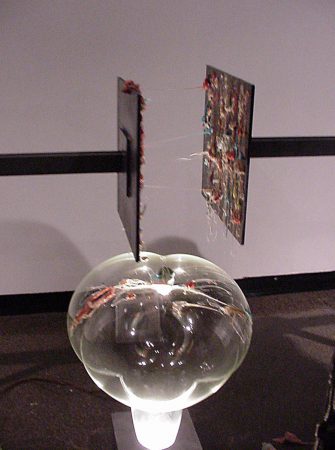Standby Deliver – consists of sugar-powered perception, activated by steel plates facing each other and moving back and forth attached to activating motors. Underneath is a lit glass sugar molecule.
Visitors have access to chewing gum, which they chew and stick to the chewing plates, which will stretch out, creating long colorful strings of the sticky substance. After many cycles of the plate’s back-and-forth motion, the glass sugar molecule is coated with the bright colorful goo.

This human-activated system uses sugar, gum, and machine as metaphors for human consumption and the waste cycle while offering mouth and eye candy, to help the participant question the impact of their addictive consumerist behavior and the sugar-tweaked cognition that results.
The origin of this piece is based on obsessive consumer behaviors, including my own.
I admit freely to being a sugar addict (now and again). My consuming behavior can have me chewing 4 packs of gum in a matter of 50 minutes. I usually get spearmint, peppermint, fruit, and cinnamon, which I end with.
The cinnamon flavor seems to be all I can taste after the other intense preparations. The large gum wad that results is quite annoying and is partly associated with the accidental chunks found on the bottom of my shoes or my pant knees from the underside of school desks.

Gum base seems to coat everything in the modern city and is probably as prevalent as cigarette butts as the most common artificial sidewalk flora.
I am often amused by Singapore laws forbidding gum consumption in their clean city and wonder when class action suits will charge Wrigley to clean up our sidewalks and public benches.

My solution to the unsightly wad is to put them in sheets of white or black paper. I often pulled the paper open and found that the patterns were quite beautiful, like 3-dimensional Rorschach tests.
Usually, I would make collages with these bits of gum but had never seen them as precious enough to save; they invariably end up in the garbage after a blood sugar low, crash-and-burn.
As I ponder these Rorschach-test-gum-vignettes, I wonder if all the sugar in my body and brain was affecting my perception of their beauty.
Was the sugar addiction driving the mouth candy to become eye candy? I am always amazed that the first ingredient in gum is sugar and the gum rubber base is just the medium, the delivery system, for this sugar.
Somehow gum seems to be the ultimate metaphor for the American consumerist way. Plastic wraps, large containers, cardboard boxes, gum bases, etc., which are just delivery systems, have long-term environmental impacts that are not often considered.

“Standby Deliver,” a machine that involves human participation, will allow me to reference people as part of this machine. A system of making, consumption, and disposal.
Their choice of eating and placing it on the work will allow them to consider their complicity in this machine system.
Allowing the viewer/participant to place the gum onto plates, stretching the gum onto glass sugar molecule forms, will help identify sugar as a primary drug.
This may or may not cause people to question the impact of their addictive consumerist behavior. Still, it will undoubtedly involve them in the act of making, becoming part of the American sugar way and the sugar-tweaked cognition that results.
Exhibitions
KOHLER ARTS CENTER Sheboygan, Wisconsin. Feb. 24-Jun. 9, 2002
Organic/Mechanic Exhibition curated by Lena Vigna. Displayed Standby Deliver digestive sculpture.
HOPKINS HALL GALLERY, OHIO STATE, Columbus, Ohio. Oct. 2001
New Works Faculty Exhibition. Displayed Standby Deliver digestive sculpture.
THE ART INSTITUTE OF CHICAGO BETTY RYMER GALLERY, Chicago, Illinois. Jan. 1999
IN:FORMATION Exhibition curated by Sine::Apsis Chicago artists’ collective.
Standby Delivers’s premiere is a digestive sculpture involving the ingestion of sugar and gum.
Technical
Special thanks to Robert Wiley for research in blowing molds of sugar molecules and the Department of Art at The Ohio State University Glass Area. The molds were very clever, and Robert Wiley did this brilliant fabrication.






